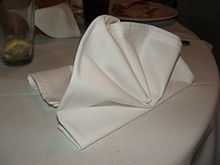Napkin

A napkin, or face towel (also in Canada (some parts), the United Kingdom, Australia, New Zealand and South Africa: serviette) is a rectangle of cloth used at the table for wiping the mouth and fingers while eating. It is usually small and folded, sometimes in intricate designs and shapes. The word comes from Middle English, borrowing the French nappe—a cloth covering for a table—and adding -kin, the diminutive suffix.
Terminology
In the United Kingdom and Canada both terms, serviette and napkin, are used. In the UK, napkins are traditionally U and serviette non-U. In certain places, serviettes are those made of paper whereas napkins are made of cloth.[1] The word serviette in lieu of the term napkin is not typically used in American English, though, as discussed is not unheard of in Canadian English and Canadian French. In Canada the term was used until the late 70's and very early 1980's to mean a paper napkin, though very few people use it today, but instead use "napkin". In Australia, 'serviette' generally refers to the paper variety and 'napkin' refers to the cloth variety.
Description and history
Conventionally, the napkin is often folded and placed to the left of the place setting, outside the outermost fork. In an ambitious restaurant setting or a caterer's hall, it may be folded into more or less elaborate shapes and displayed on the empty plate. Origami techniques can be used (replacing the traditional paper method with the serviette/napkin) to create a 3D design e.g. a crane (bird). A napkin may also be held together in a bundle (with cutlery) by a napkin ring. Alternatively, paper napkins may be contained with a napkin holder.
Napkins were used in ancient Roman times. One of the earliest references to table napkins in English dates to 1384–85.[2]
Summaries of napkin history often say that the ancient Greeks used bread to wipe their hands. This is suggested by a passage in one of Alciphron's letters (3:44), and some remarks by the sausage seller in Aristophanes' play, The Knights.[3] The bread in both texts is referred to as apomagdalia, which simply means bread from inside the crust known as the crumb, and not special "napkin bread".[4] The use of paper napkins is documented in ancient China, where paper was invented in 2nd century BC.[5] Paper napkins were known as chih pha, folded in squares, and used for the serving of tea. Textual evidence of paper napkins appears in a description of the possessions of the Yu family, from the city of Hangzhou.[6]
See also
| Wikimedia Commons has media related to Napkins. |
- paper napkins
- sanitary napkin
- wet wipe
- Nardwuar
References
- ↑ On-line discussion of the uses of serviette and napkin at wordreference.com
- ↑ Oxford English Dictionary
- ↑ Harry Thurston Peck, Harpers Dictionary of Classical Antiquities, 1898
- ↑ Liddell and Scott, Intermediate Greek-English Lexicon, 1889
- ↑ Tsien, Tsuen-Hsuin (1985). Paper and Printing. Joseph Needham, Science and Civilisation in China, Chemistry and Chemical Technology. 5 part 1. Cambridge University Press. p. 38.
- ↑ Joseph Needham (1985). Science and Civilisation in China: Paper and Printing. Cambridge University Press. p. 122. ISBN 978-0-521-08690-5. "At this time, tea was served from baskets made of rushes which held tea cups with paper napkins (chih pha)."
http://www.vocaboly.com/forums/ftopic7027-15.html
External links
| Look up napkin in Wiktionary, the free dictionary. |
- Napkin Folding Tutorials, a huge collection of step by step video tutorials on how to fold napkins
- Serviettes and How to Fold Them, a guide to folding napkins from 1890.
| ||||||||||||||||||||||||||